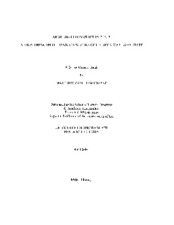| dc.description.abstract | This project is a re-visitation of the 20-year period of Arab-Israeli conflict immediately following the United Nations' creation of the state of Israel. It focuses on U.S. policy towards the Arab-Israeli dispute by examining the public speeches of the U.S. secretaries of state. When necessary, the scope of documents is widened to include internal State Department papers, the memoirs of the secretaries of state, public speeches by other Department of State officials, and general historical accounts of Arab-Israeli and Middle Eastern events. The written materials are used to determine the different pressures that cause U.S. policy shifts, to evaluate any static or evolving policy trends, and to generate an historical sketch of U.S. involvement. The pressures on U.S. policy that are examined include communism, the United Nations, the economic effects of Middle Eastern oil, arms shipments to Arab and Israeli interests, the Palestinian refugees, and the domestic political influence on U.S. officials. After the initial establishment of U.S. policy in 1947 and 1948, the secretaries of state attempted to maintain a consistent tone towards Arab-Israeli issues. The role of the Cold War, however, made this endeavor increasingly difficult as the U.S. and the Soviet Union inched closer to armed conflict. This factor would weigh just as heavily as economic concerns on U.S. policy in the Middle East over the twenty year span. The other factors examined, while important in the overall scheme, did not substantially impact U.S. policy as much as the Cold War and economic interests. While each secretary of state and subsequent presidential administration did try to make progress in removing the Arab-Israeli disputes, the consistency of the pressures on U.S. policy produced a stagnant atmosphere not conducive to change or improvement. All of these pressures, with the exception of the role of communism, still exist today, along with a newer, more intense threat of Arab resentment towards the United States; their existence continues to plague U.S. policymaking towards the Arab-Israeli conflicts. | en |


